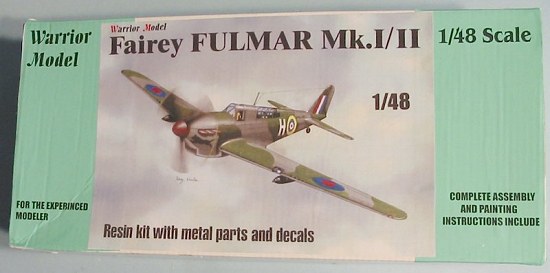
Warrior Models 1/48 Fairey Fulmar I
| KIT #: | ? |
| PRICE: | $90.00 MSRP |
| DECALS: | See review |
| REVIEWER: | Tom Cleaver |
| NOTES: | Resin kit with vac canopies. |

| HISTORY |
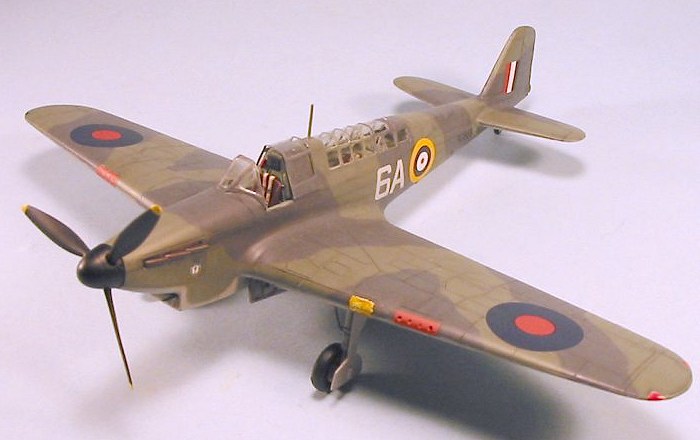
Navies operating aircraft carriers in the mid-1930s were faced with a new difficulty as a result of the technological revolution in aircraft development. The new land-based bombers, which were foreseen at the time as the carrier’s greatest possible enemy, were much faster than their predecessors, with increased range and bomb load. Countering the bomber was a problem for the fleet, inasmuch as there was at the time no way of spotting an incoming attack when it was far enough away from the fleet to allow interceptors to be launched from the carrier with any hope of arriving at the enemy’s altitude in time to prevent the attack. This was especially a problem for the Royal Navy, inasmuch as its most likely operating areas were the North Sea and the Mediterranean, bodies of water that were small enough to be well within range of land-based aircraft at all times. While radar would eventually solve this problem, its development and use was unseen at the time.
The only answer to this problem that could be seen at the time was to create a fleet defense fighter capable of maintaining standing patrols at altitude far enough from the fleet to allow the spotting and interception of incoming raids. For the Fleet Air Arm, this meant a two-seat aircraft, since it was believed the pilot would not be able to navigate and maintain long distance radio contact with the home carrier, since long-range radio communication at the time was strictly via Morse Code. Given the limited space on board a carrier, it was also desirable for the fleet defense fighter to be capable of performing other missions, such as dive-bombing and general reconnaissance.
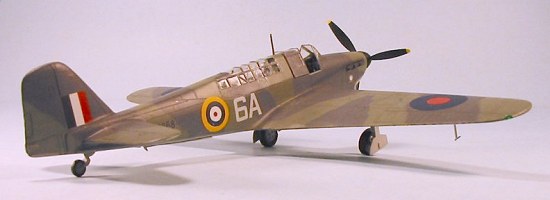 The first fleet defense fighter was the Hawker Osprey, a development of the
Hawker Hart, which had been a two-seat light day bomber with performance
superior to RAF fighters at the time of its first appearance in 1929. By
the mid-1930s, however, the Osprey was long in the tooth and bomber
development in potential enemy nations clearly demonstrated a need for an
airplane with increased performance.
The first fleet defense fighter was the Hawker Osprey, a development of the
Hawker Hart, which had been a two-seat light day bomber with performance
superior to RAF fighters at the time of its first appearance in 1929. By
the mid-1930s, however, the Osprey was long in the tooth and bomber
development in potential enemy nations clearly demonstrated a need for an
airplane with increased performance.
The answer was thought to be the Skua, first produced by Blackburn Aircraft in 1934. However, by 1937 development difficulties with this design and that of the basically-similar Roc made it obvious that the 190 Skuas and 137 Rocs on order would not be in service by 1938. Additionally, there were those in the Admiralty who were beginning to realize that the 198 m.p.h. top speed the design was capable of was not going to be enough for the mission.
In light of the perceived emergency, it was decided the Navy needed to take up the development of an airplane that already existed, which could be modified to become the new fleet defense fighter. The merits of the Fairey P.4/34 and the Hawker Henley - which had first appeared as replacements for the Fairey Battle light bomber - were considered in January 1938. The P.4/34 design was chosen for further development due to Hawker’s commitment to Hurricane production. Fixed armament was specified as eight .303 caliber machine guns, and the mount designed for the Hurricane was adopted. The size of the aircraft allowed for a doubling of the ammunition load over that of the Hurricane, and it was capable of flying a 6-hour patrol mission. While the P.4/34 had a machine-gun in the rear cockpit for use by the observer, this was deleted in the fighter - a decision that would later be regretted.
While the Admiralty would have preferred a radial engine powerplant, there was none available providing sufficient power, so the moderately-supercharged Merlin “H” was specified. This was produced as the Merlin VIII, providing 1,080 h.p. Given that the design weighed in at nearly 9,000 pounds - double that of a similarly-powered Hurricane - it was not surprising that the maximum speed was only 265 m.p.h. at 7,000 feet. Since the operating strategy for the carriers was to remain out of the operating range of single-seat land-based fighters, this performance was considered sufficient to chase the bombers the airplane was designed to fight. The design was frozen in May 1938, at which time the aircraft was named “Fulmar” for the large sea bird. The Munich Crisis that fall saw an increase in the production order from 100 to 250.
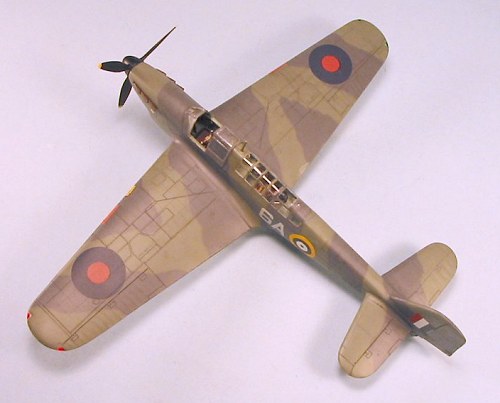 The Fulmar prototype N1854 was first flown on 4 January 1940 at Ringway and
served as the first production aircraft. Testing was successful and N1855
was sent for tests at C squadron, A&AEE Boscombe Down, in May 1940. Fulmars
were delivered to 778 Squadron that month for service test and development.
Such was the need, Fulmars were delivered to 806 Squadron for operation
from the new armored carrier HMS “Illustrious” in June 1940 with final
equipment by the end of July. That August, “Illustrious” departed for
service in the Mediterranean.
The Fulmar prototype N1854 was first flown on 4 January 1940 at Ringway and
served as the first production aircraft. Testing was successful and N1855
was sent for tests at C squadron, A&AEE Boscombe Down, in May 1940. Fulmars
were delivered to 778 Squadron that month for service test and development.
Such was the need, Fulmars were delivered to 806 Squadron for operation
from the new armored carrier HMS “Illustrious” in June 1940 with final
equipment by the end of July. That August, “Illustrious” departed for
service in the Mediterranean.
Outclassed by contemporary land-based fighters, the 15 Fulmars of 806 Squadron were nevertheless an advance over the three Sea Gladiators being operated by HMS “Eagle,” which were the sole Fleet Air Arm fighter strength in the eastern Mediterranean at that point.
806 entered combat against aircraft from the Regia Aeronautica while protecting Malta bound convoys in September 1940. Fortunately, “Illustrious” was equipped with radar, which allowed the fighter directors aboard to position the Fulmars for effective interception of the speedy S.M.79 bombers, which had a top speed approximately the same as the fighter. 806 would also take part in the Taranto Raid on November 11. By the end of 1940, 806 Squadron’s 15 Fulmars had shot down 26 Italian aircraft and damaged a further 28. On January 10, 1941, the Fulmars were overwhelmed by the Ju-87 dive bombers of the Luftwaffe’s X Fliegerkorps, with the result that HMS “Illustrious” was nearly sunk when struck by six direct hits, only just making it into Malta. 806 then provided fighter escort to Swordfish torpedo bombers operating from Malta for the remainder of January, before moving to Crete, where they were eventually relieved by the similarly-equipped 805 Squadron and went on to join 803 Squadron aboard HMS “Formidable” upon that carrier’s arrival in the eastern Mediterranean in late February. On March 28, the aircraft of both squadrons participated in the Battle of Cape Matapan, escorting the new Albacore torpedo bombers in strikes that crippled the battleship “Vittorio Veneto” and cruiser “Pola.”Plagued by a shortage of aircraft, 803 and 806 continued to operate from “Formidable” until May 26, 1941, when she was heavily damaged in an attack by Ju-87s of II/StG2 that again overwhelmed the aerial defenders. After this, the combined score of the two squadrons stood at 56 destroyed and 33 damaged, nearly half the total of enemy aircraft that would fall to the Fulmar during its first-line career.
In the western Mediterranean, 807 and 808 Squadrons aboard HMS “Ark Royal” shot down 30 enemy aircraft during three Malta convoys prior to the ship’s loss to a U-boat in November 1941, with their most important action being the interception of S.M.79 torpedo bombers and Ju-88 dive bombers on May 8, 1941 during Operation Tiger, a trans-Mediterranean convoy to deliver desperately-needed supplies to British forces in Egypt. With only 12 Fulmars available, the two squadrons held off repeated attacks until the ship returned to Gibraltar, enabling five of the six ships in the convoy to deliver 200 tanks and 43 Hurricanes. During Operation Substance, a Malta convoy in July, ten S.M.79s were destroyed with a loss of five Fulmars, and a force of Cant Z.1007 bombers was driven off.
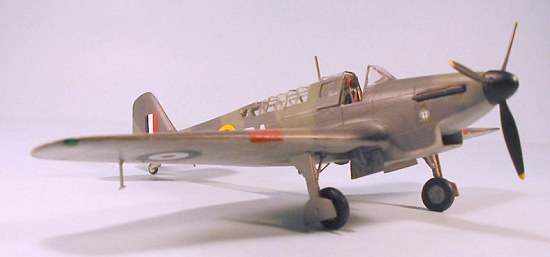 The Mk.I was rapidly replaced in the summer of 1941 by the Mk.II, which had
entered production that spring with a 1,300 h.p. Merlin 30 power plant.
While maximum speed only went up another 10 m.p.h., the Fulmar Mk.II could
outclimb the navalized Hurricane just entering service and offer a
generally-similar overall performance below 10,000 feet, and could also
carry two 250 lb. bombs for strike missions.
The Mk.I was rapidly replaced in the summer of 1941 by the Mk.II, which had
entered production that spring with a 1,300 h.p. Merlin 30 power plant.
While maximum speed only went up another 10 m.p.h., the Fulmar Mk.II could
outclimb the navalized Hurricane just entering service and offer a
generally-similar overall performance below 10,000 feet, and could also
carry two 250 lb. bombs for strike missions.
Throughout the Fulmar’s period of combat service, the armament was seen as too light to be truly effective against such opponents as the Ju-88 and the S.M.79. Studies were made of increasing the armament to four 20mm cannon, but the weight penalty was too much. One Fulmar Mk.II had its eight .303 machine guns replaced by a similar number of .50 caliber weapons, but again the weight penalty was too great. Had the Fulmar carried even an armament of four of these weapons, it might well have managed to destroy those enemy aircraft listed as damaged. By the time the Fulmar was withdrawn from front-line fleet service on August 12, 1942, it was responsible for the destruction of 112 enemy aircraft in air combat and over 80 damaged. Since this was 30 percent of the total Royal Navy carrier-based fighter victories in the entire war, this represents a considerable success for a fighter that was an emergency makeshift, designed and produced in extreme haste, which never outperformed its adversaries.
N1854, the first Fulmar, was used as the development airframe for the Fulmar Mk.II, and was purchased by Fairey from the Royal Navy in August 1945. Granted a civilian registration in 1946, the Fulmar was used by a hack by Fairey until 1959. The airplane was flown in displays from 1951 to 1962, when it was taken out of service and given to the Royal Navy. It exists today as a display at the Fleet Air Arm Museum in Yeovilton, the only one of its kind left of 250 Fulmar Is and 350 Fulmar IIs produced.
| THE KIT |
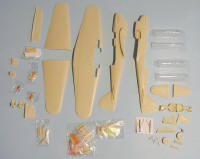 So far as I am aware, the first Fulmar in kit form was a very nice vacuform
produced by Rareplanes in the early 1970s, followed by an injection molded
kit from Vista - later re-released by Revell of Germany, and a recent
limited-run kit from Special Hobby. This kit by Warrior Models of Poland
is the only 1/48 release of the Fulmar. Produced in cast resin with
vacuformed canopies and white metal landing gear, this is easily the best
of the kits released to date by this Polish “garage kit” manufacturer. The
surface detail is the best I have seen on any kit since the Tamiya Wildcat
as regards the petite raised rivet detail that is correct for this
airplane. Production design of the parts is also improved, which leads to
much easier construction than that I experienced building the Blackburn
Skua and Roc kits previously released. Two complete sets of vacuform
canopies, with extra canopies to allow you to open the rear cockpit if you
so desire, are provided.
So far as I am aware, the first Fulmar in kit form was a very nice vacuform
produced by Rareplanes in the early 1970s, followed by an injection molded
kit from Vista - later re-released by Revell of Germany, and a recent
limited-run kit from Special Hobby. This kit by Warrior Models of Poland
is the only 1/48 release of the Fulmar. Produced in cast resin with
vacuformed canopies and white metal landing gear, this is easily the best
of the kits released to date by this Polish “garage kit” manufacturer. The
surface detail is the best I have seen on any kit since the Tamiya Wildcat
as regards the petite raised rivet detail that is correct for this
airplane. Production design of the parts is also improved, which leads to
much easier construction than that I experienced building the Blackburn
Skua and Roc kits previously released. Two complete sets of vacuform
canopies, with extra canopies to allow you to open the rear cockpit if you
so desire, are provided.
| CONSTRUCTION |
With any limited-run resin kit, construction starts with cleanup of the parts. For the most part, the parts were quite clean to begin with. As I test-fitted things, I saw that fit was superior to the previous kits, and that - with some care in assembly - it might be possible to retain almost all the beautiful surface detail. In fact, as I was test-fitting things upon clean-up, it struck me that if I could make the joints as clean and narrow as possible, I really could get a “no putty” build. I took out the trusty Dremel and ground down all the joints at an angle from inside, so that when fitted together the joint was no thicker than would be the case with an injection-molded kit. The result was that when it came time to assemble the model, I only needed to use Mr. Surfacer directly along the joints, making for a very clean assembly.
 Next
up was to paint the cockpit interiors and assemble the parts. The kit
provides sufficient interior detail to make the cockpits look good - an
important point when one has as much glass in the two canopies as this kit
provides. Once painted and the cockpits assembled, I glued together the
fuselage halves with cyanoacrylate glue. By working slowly and only gluing
a few inches at a time, I was able to get a good close fit everywhere but
along the lower fuselage centerline just aft of the wing. Cleaning this up
required a heavy dose of Mr. Surfacer 500, but that was all.
Next
up was to paint the cockpit interiors and assemble the parts. The kit
provides sufficient interior detail to make the cockpits look good - an
important point when one has as much glass in the two canopies as this kit
provides. Once painted and the cockpits assembled, I glued together the
fuselage halves with cyanoacrylate glue. By working slowly and only gluing
a few inches at a time, I was able to get a good close fit everywhere but
along the lower fuselage centerline just aft of the wing. Cleaning this up
required a heavy dose of Mr. Surfacer 500, but that was all.
I then assembled the wing, which had a well done set of resin main gear wells. By dremeling along the inside trailing edge of the wing parts, I was able to get a thin trailing edge when assembled. I only needed some Mr. Surfacer along the leading edge joint of the wings.
I carefully test-fit the wing to the fuselage, and dremeled along the attachment area of the fuselage to get a nice fit. When I glued the wing to the fuselage, I found a gap along the upper surface joint on both sides, which was filled with cyanoacrylate and left to dry naturally. The joint only needed some Mr. Surfacer 500 and a light sanding-down to disappear.
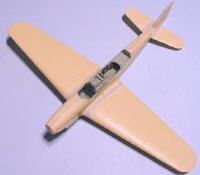 The only “difficult” part of the entire assembly was discovering after I
had attached the horizontal stabilizers, when I saw that they were too
swept back. I broke them off the fuselage, made certain the elevator hinge
line was at 90 degrees to the fuselage centerline, drew the correct angle
on the stabilizer and cut it with a razorsaw.
The only “difficult” part of the entire assembly was discovering after I
had attached the horizontal stabilizers, when I saw that they were too
swept back. I broke them off the fuselage, made certain the elevator hinge
line was at 90 degrees to the fuselage centerline, drew the correct angle
on the stabilizer and cut it with a razorsaw.
The rear canopy went on without difficulty, and I used a little Mr. Surfacer along that joint line to fill it in and smooth things out. The front canopy gave me some fit problems which I solved by cutting the windshield off the canopy and then attaching the windscreen separately, with plans to pose the canopy open.
I then attached the landing gear. The kit is heavy, and the very petite white metal tail wheel was very definitely not going to stand up to the stress of supporting the rear of the model, so I replaced it with an injection-molded tail wheel of approximately the right dimensions culled from the spares box. I also replaced the kit propeller with a prop and spinner out of the spares box; had I not had this available, the kit prop would have been just fine.
I finished the assembly by masking the canopies and painting the model overall in light grey, to see if I had indeed gotten all the seams. I found some seams needing a second coat of Mr. Surfacer 500, and when that was taken care of all was ready for painting.
| COLORS & MARKINGS |
Painting:
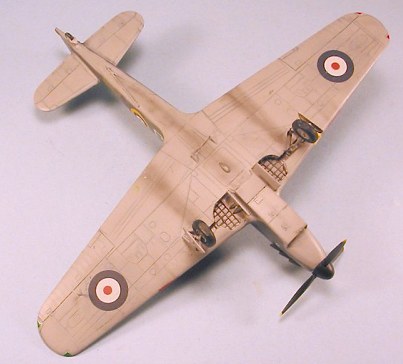 I first pre-shaded the model by airbrushing black over all the panel
lines. I then painted the lower surfaces with Tamiya Sky Grey. (Fleet Air
Arm aircraft did not have Sky undersurfaces until April 1941.) I used
Tamiya “Dark Grey” for the Dark Sea Grey and Tamiya “RLM Grey” for Dark
Slate Grey for the upper surface camouflage, with each color “post shaded”
by adding in some light grey and going back over the panel lines. Since
the ultimate model was to be of an 806 Squadron airplane in the Fall of
1940, when these airplanes were still relatively new, I was only going for
a small amount of sun-fading and saltwater corrosion to the paint scheme.
I used the 4-view profiles in the Profile Publication for the Fulmar to
freehand the camouflage pattern.
I first pre-shaded the model by airbrushing black over all the panel
lines. I then painted the lower surfaces with Tamiya Sky Grey. (Fleet Air
Arm aircraft did not have Sky undersurfaces until April 1941.) I used
Tamiya “Dark Grey” for the Dark Sea Grey and Tamiya “RLM Grey” for Dark
Slate Grey for the upper surface camouflage, with each color “post shaded”
by adding in some light grey and going back over the panel lines. Since
the ultimate model was to be of an 806 Squadron airplane in the Fall of
1940, when these airplanes were still relatively new, I was only going for
a small amount of sun-fading and saltwater corrosion to the paint scheme.
I used the 4-view profiles in the Profile Publication for the Fulmar to
freehand the camouflage pattern.
When all was dry, I gave the model a coat of Future and it was time for decals.
Decals:
The kit decals are incorrect, being the same sheet provided for the Skua and Roc. The national insignia are the right size, though the red is a bit bright; without replacements available, they would be acceptable. I went through the decal dungeon and culled insignia and markings from other RAF and FAA decal sheets, to create the 14th production Fulmar Mk.I, one of the first assigned to 806 Squadron aboard HMS “Illustrious” in the Eastern Mediterranean in the fall of 1940.
| FINAL CONSTRUCTION |
After the decals were set and the model was washed off, I gave it another coat of Future, followed by two coats of Dullcote to flatten the finish. I weathered the model by giving it exhaust and gunfire stains using Tamiya “Smoke.” I then unmasked the canopies and attached the forward canopy in the open position.
| CONCLUSIONS |
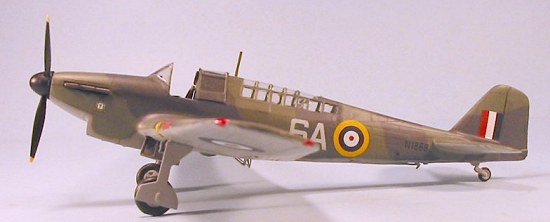 This is a good resin kit of a rare airplane. While pricey, it delivers
with good quality. There are constant rumors of some limited-run company
eventually providing an injection-molded kit of the Fulmar. However, the
one manufacturer I know who is adventurous enough to consider such a thing
concluded a couple years ago that the possible market for a Fulmar seemed
pretty limited. Never say never - people were convinced when the MDC resin
Swordfish came out in 1997 that no one would ever release an
injection-molded Swordfish - but I really think that this is likely to be
the best 1/48 Fulmar we’re going to see available, at least in the
foreseeable future. Those Fleet Air Arm fans who take the plunge with this
kit will be rewarded with a good-looking model in the end, that is not that
difficult a project. Tadeusz has told me he will be releasing a Fulmar
Mk.II later this year. Now, if I can just convince him to do some more
research on the Albacore and bring it out, I will have a complete
collection of Fleet Air Arm aircraft of the Second World War, of which this
kit is a worthy addition.
This is a good resin kit of a rare airplane. While pricey, it delivers
with good quality. There are constant rumors of some limited-run company
eventually providing an injection-molded kit of the Fulmar. However, the
one manufacturer I know who is adventurous enough to consider such a thing
concluded a couple years ago that the possible market for a Fulmar seemed
pretty limited. Never say never - people were convinced when the MDC resin
Swordfish came out in 1997 that no one would ever release an
injection-molded Swordfish - but I really think that this is likely to be
the best 1/48 Fulmar we’re going to see available, at least in the
foreseeable future. Those Fleet Air Arm fans who take the plunge with this
kit will be rewarded with a good-looking model in the end, that is not that
difficult a project. Tadeusz has told me he will be releasing a Fulmar
Mk.II later this year. Now, if I can just convince him to do some more
research on the Albacore and bring it out, I will have a complete
collection of Fleet Air Arm aircraft of the Second World War, of which this
kit is a worthy addition.
August 2004
Copyright ModelingMadness.com. All rights reserved. No reproduction in part or in whole without express permission.
Review Kit courtesy of Warrior Models
If you would like your product reviewed fairly and quickly, please contact me or see other details in the Note to Contributors.